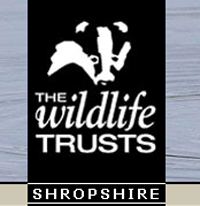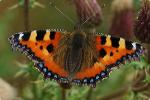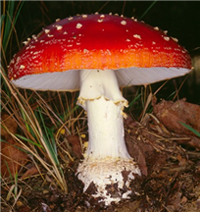Wednesday 29th October 2025, Ketley Paddock Mound
This is my last report.
After 14 seasons at the helm of the Joy of Wildlife group and its predecessors I am stepping back from making the arrangements, including writing the reports.
This does not mean the end. Joy of Wildlife will continue as a group of regular attendees take over all the aspects of running the group. This includes the reports which will now be edited by David.
Please indulge me for a little while.
Little did I suspect when I arranged a few outings for friends and colleagues of the Wrekin Forest Volunteers and Invertebrate Challenge attendees in 2012 that I would still be arranging trips in 2025!
In that time, we have made 555 visits (by my reckoning) to over 270 different sites in and around Shropshire, contributed over 65,000 records to the County’s and Nation’s biological data, and were recognised nationally as the Recording Group of the Year in 2019.
Despite the serious aims of the group, we have met as friends doing what we all enjoy doing and had a thoroughly enjoyable time. I have been very lucky to be associated with all the people who have attended over the years.
The group has been dynamic as people drifted in and drifted out, but a few have kept me company throughout. During this time we have welcomed all-comers, from those who just want a day out looking at nature, those who are only interested in photographing wildlife, those who are beginning their interest in nature and experienced biological recorders.
In such a long period we have inevitably lost members, and I would like to finish by remembering those who have passed away over this time. (I apologise if I have missed anybody.)
Mike Coutts
Brian Herring
Paul Watts
Christine Littlewood
Stephen Mitchell.
Visit 555 – Paddock Mound
Paddock Mound is a Local Nature Reserve in Ketley. It is about 11 acres in area and was formed by iron ore workings in the 18th century. Nature has now reclaimed the abandoned spoil mounds.
The vegetation is predominantly mixed woodland and acidic grassland. The site also has three bodies of water, the largest of which is the remnant of the former Ketley Canal.
Having met in the nearby car park we made our way to the site. Our first stop was a pool, the smallest water body.
We searched through the vegetation around the pool edge and close-by, noticing this Oyster Mushroom, Pleurotus ostreatus, on a log.
Suction sampling the poolside vegetation revealed a Common Shiny Woodlouse, Oniscus asellus.
Sweeping the vegetation caught a caddis fly, Limnephilus marmoratus.
The first of many species of ladybird that we found and photographed was the invasive Harlequin Ladybird, Harmonia axyridis. This ladybird is so common now that it is hard to believe it only arrived in Britain about 20 years ago.
In amongst a suction sample, we found this fly larva with attendant springtails hitching a ride.
Time to move on.
Passing the canal, we climbed some rather awkward steps to a grassland area.
This is where we spent the remainder of the morning, searching through the grass, the surrounding vegetation and trees, and the oak trees standing in the middle.
The finds in this area came in thick and fast.
Hairy Shieldbug, Dolycoris baccarum.
A distinctive sputnik-shaped egg-sac, with exit holes, on the underside of an Oak leaf, of the spider Paidiscura pallens.
Some shieldbug eggs which we think were laid by a Gorse Shieldbug, Piezodorus lituratus…
And an adult.
The Friends of Ketley Paddock Mound website states that the site's elevation provides excellent views to the North and West. Unfortunately the trees surrounding the grassland severely restrict the view to the west but at one spot the marginal vegetation parted to provide a view of The Wrekin.
Lunch was taken at and around a picnic table close to the above view-point.
After the break we moved into a second, larger, area of grassland.
The pattern of searching was similar to the first area as we slowly made our way down to the far end of the site.
A Hawthorn Shieldbug, Acanthosoma haemorrhoidale, was found languishing in an Oak tree, clearly it is not Botanist!
A Common Wasp, Vespula vulgaris, joined the group for a while.
And beating the wet marginal vegetation knocked out a banded snail.
A series of ladybirds followed:
A 16-spot Ladybird, Tytthaspis sedecimpunctata;
 |
| Photograph: Nigel Cane-Honeysett |
And three for the price of one – a 10-spot (Adalia decempunctata), a 14-spot (Propylea quattuordecimpunctata) and a 7-spot (Coccinella septempunctata).
Then we found a species that we have been finding nearly everywhere we go since we were able to identify it nearly two years ago, the parasitic wasp, Callitula pyrrhogaster. This is normally found by suction sampling and requires very patient, dedicated, inspection of all the dots in the sampling tray to see which ones move and then identify the insect. It is rarely found by just glancing at the contents.
Searching a tree revealed a Birch Shieldbug, Elasmostethus interstictus.
Our exploration continued as we were joined by a couple of the “Friends” group who had a look at what we had found and had a general chat about the site.
Towards the end of this area of grassland we came across a couple of small patches of Heather, Calluna vulgaris.
And around this area we also found Butterfly Stonecrop, Hylotelephium spectabile.
Rather like the morning all sorts of species came out to say “Look at me”.
A missing sector spider, Zygiella x-notata.
An Adonis’ Ladybird, Hippodamia variegata.
A leaf-mining fly, Liriomyza congesta, recognised by the pattern of the mine and frass in the leaf.
A pseudoscorpion, Neobisium carcinoides.
A Green Shieldbug, Palomena prasina.
A Cream-spot ladybird, Calvia quatuordecimguttata.
A Bristly Ladybird, Rhyzobius lophanthae, was beaten out of a tree. This is another recent arrival. Its origins are in Australia. It was brought to Europe as a bio-control species and it spread to the UK in 1999.
A Selfie…
Smile everyone…
Or look busy!
Back to the “work in hand”. Beating Gorse disturbed a lace bug, Dictyonota Strichnocera.
And inspecting a patch of nettles turned up the relatively large ground bug Heterogaster urticae.
Time was marching on, and we joined it by moving relatively swiftly to the third water body.
As you can see from the above photograph, the pond has largely been taken over by vegetation but there was some more open water on which a Moorhen, Gallinula chloropus, passed the time of day.
Suction sampling the vegetation at the side of the path that ran alongside the pool revealed a Dock Bug, Coreus marginatus.
Our time was up and we made our way back to the cars, spotting lying on the tarmac this wee fellow, which seems a good way to end.
My thanks to Telford and Wrekin Council for giving us permission to do what we enjoy doing.
My gratitude to the photographers for their excellent images for this and all previous issues of this report. Without their skills and persistence these reports would have been very dull affairs.
And finally, many thanks to all the people who have read these ramblings over the years. It has been a pleasure reporting, in a not too serious way, on the “achievements” of the group.
Please continue to support my successor, David, as he takes on this activity.
Au revoir.




























































































